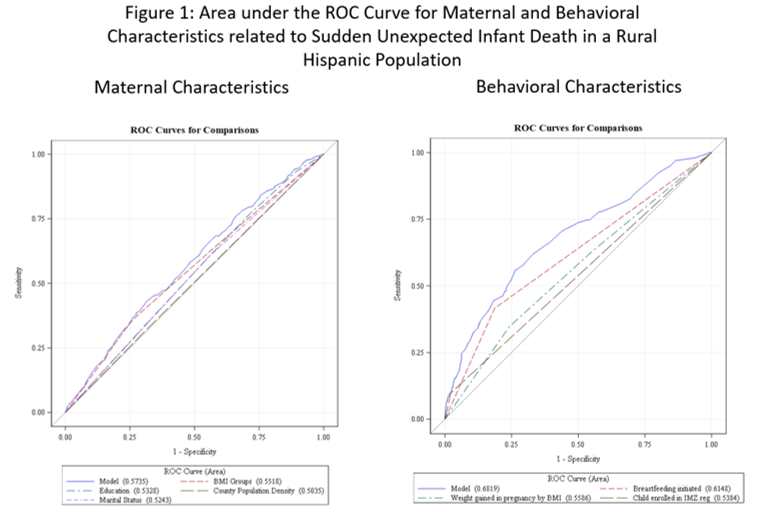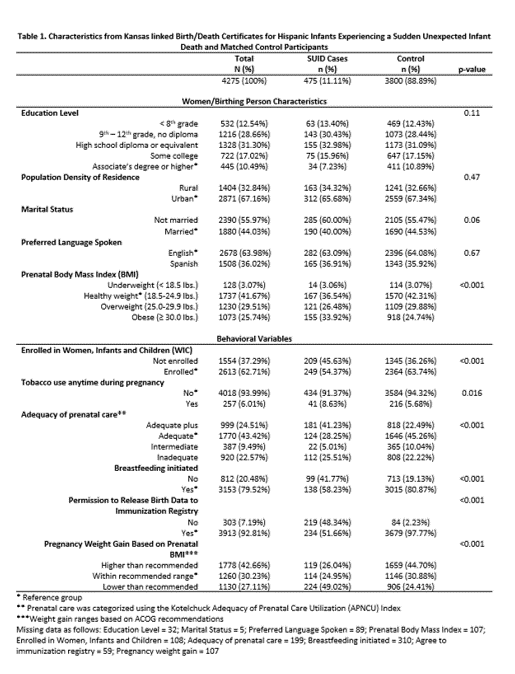Public Health & Prevention
Public Health & Prevention 2
103 - Sudden Unexpected Infant Death in a Rural Hispanic Population: A Case-Control Study
Publication Number: 103.15

Carolyn Ahlers-Schmidt, PhD (she/her/hers)
Director of Pediatric Research
University of Kansas School of Medicine-Wichita
University of Kansas School of Medicine-Wichita
Wichita, Kansas, United States
Presenting Author(s)
Background: In the US, sudden unexpected infant death (SUID) is the leading cause of death among infants aged 28 days to 1 year. The SUID rate for Hispanic infants is often lower than for other infants, but still accounts for 17% of deaths in Kansas. Further, the Hispanic SUID rate between 2005 and 2018 did not change, in contrast to the rates for non-Hispanic Black and White infant which decreased.
Objective: To identify a) characteristics of women/birthing persons (WBP) and b) perinatal behaviors related to SUID among Hispanic families.
Design/Methods: Vital statistics data, including linked Kansas birth/death data (2005-18) for Hispanic WBP with singleton births, were explored. To reduce confounding effects, greedy nearest neighbor matching paired each WBP sequentially with the 8 nearest controls based on age, race, payor source and parity. Matching procedures, likelihood-ratio χ2, Fisher exact test and multiple logistic regression model with Firth’s penalized maximum likelihood estimation were computed using SASv.9.4.
Results:
Of 86,792 Hispanic singleton births, 475 involved SUID and were matched with 3,800 controls from a pool of 83,758 WBPs (Table 1). In terms of SUID risk, no differences were found related to population density of residence, marital status or language spoken (all p< 0.05). However, Hispanic WBPs who experienced SUID were more likely to have lower education [(9–12th grade with no diploma (30% vs 28%); χ2(1)=4.18, p=0.04); high school diploma (33% vs 31%); χ2(1)=4.64, p=0.03)], and have prenatal BMI categorized as obese (34% vs 25%; χ2(1)=15.70, p< 0.01). Multivariable models revealed predictive accuracy for SUID was poor, with area under the receiver operating characteristics (ROC) curve=0.574 (95% CI 0.55-0.60; Fig 1).
When examining perinatal behaviors, no difference was found for WIC enrollment. However, Hispanic WBPs who experienced SUID were more likely to use tobacco during pregnancy (9% vs 6%; χ2(1)=9.33, p< 0.01), have adequate plus prenatal care (41% vs 23%; χ2(1)=6.06, p=0.01), have less-than-recommended weight gain during pregnancy (49% vs 24%; χ2(1)=4.54, p=0.03), were less likely to initiate breastfeeding (58% vs 81%; χ2(1)=39.69, p< 0.01) and were more likely to refuse permission for birth data to be released to the state immunization registry (48% vs 2%; χ2(1)=21.30, p< 0.01).Behavioral multivariable models revealed better predictive accuracy, but were still inadequate, with area under the ROC curve=0.682 (95% CI 0.64-0.72).
Conclusion(s): SUID deaths to Hispanic families are likely due to multifaceted reasons. Study results inform education on risk reduction strategies.

